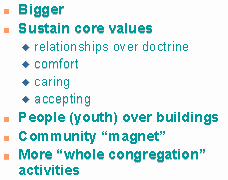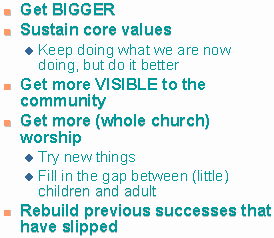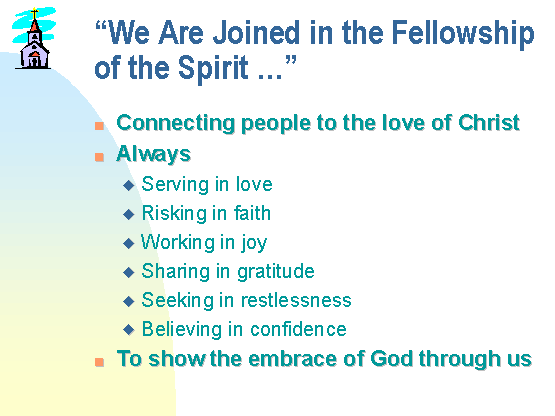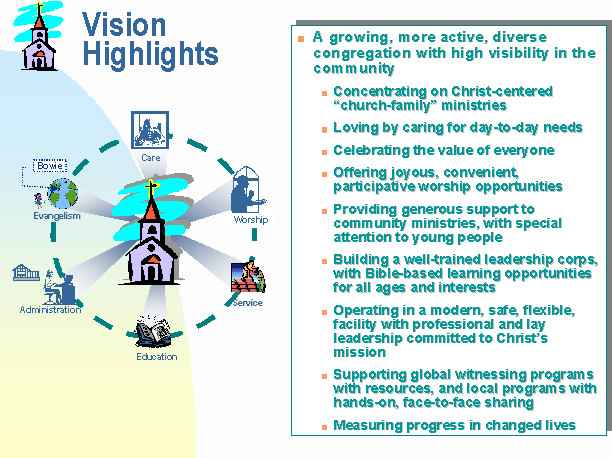Village Baptist Church
Long Range Planning Committee

Final Report
1 November 2000
Table of Contents
Village Baptist Church
Long Range Planning Committee

Final Report
1 November 2000
Table of Contents
Executive Summary *
2. The Process *
3. Who We Are *
3.2. Question 1 – "… greatest appeal of Village …" *
3.3. Question 2 – "… three ideas, activities, attitudes are most important …" *
3.4. Question 3 – "… three best successes …" *
3.5. Question 4 – "… three greatest failures …" *
3.6. Question 5 – "… continue on our current path …" *
3.7. Question 6 – "… where would you like Village to be headed …" *
3.8. Question 7 – "… what would have to change …" *
3.9. Immediate LRPC Perceptions *
4.2. Our Core Values *
6. The Six Arenas for Vision *
7. Implementing the Vision - Programs and Program Assignment *
7.2. Program Implementation and Follow-Through *
8. Conclusion *
Appendix A – Original Core Value Data Presentation a-*
Appendix B – Implementation Program Assignments
by Commission b-*
MEMBERS OF THE LONG RANGE PLANNING COMMITTEE
Near the end of 1998 Village Baptist Church established a Long Range Planning Committee to search for ways to refresh the ministry and operation of Village. More than a decade had passed since the last official church planning activity was completed. Our neighborhood and our congregation had undergone enormous changes since our last purpose statement. Following a plan suggested by Dr. Duncan McIntosh, the Committee underwent vision and growth training, and then embarked on a series of questionnaires, congregation surveys, workshops, and study activities. All of the activities were targeted first at understanding who we had been, and then searching for God’s purpose for us in the future. During the summer of 1999, a representative set of 42 members of the Village congregation were surveyed by Committee members with a brief questionnaire. The data from that questionnaire was analyzed by the Committee during the Fall of 1999, and a clear understanding of the core values and desires of Village began to emerge. The first official status report of the Committee was delivered to Village on 10 October 1999. Draft "statements of purpose" were generated, and the Committee began to identify a new vision for Village, from which specific priorities and resource allocations could be derived.
Then, Village Baptist Church burned on January 8, 2000.
The fire temporarily interrupted the work plan for the Committee. The Committee was reorganized to handle the immediate rebuilding needs of Village, and then conducted congregational workshops in March and April 2000, with progress reports to Village in May and July 2000. At the July 2000 business meeting, Village Baptist Church adopted a new Statement of Purpose:
Introduction
In late winter of 1998, Village Baptist Church (VBC) established a Long Range Planning Committee (LRPC) to search for ways to update the ministry and operation of our Church. The LRPC was originally set up because of three main reasons:
After 18 months of work, including a Committee reorganization and redirection after the fire at Village in January 2000, the LRPC has concluded its work. This report represents the final submission of the LRPC to Village. It includes all of the items already submitted to Village in business meetings and workshops (i.e., VBC Profile, Core Values, Statement of Purpose, Vision Statement, Arenas for Vision) as well as the program plan recommended by the LRPC to complete the implementation of the New Vision for Village.
Our Final Report is organized to present each of the major deliverables
prepared as the result of the LRPC’s work. Section 2 outlines The Process
followed by the LRPC. Section 3 describes Who We Are, primarily
by reviewing the survey data and presenting immediate LRPC perceptions.
Section 4 describes the resulting Profile and Core Values. Section
5 introduces our new Statement of Purpose. Section 6 proceeds to
catalog the Six Arenas for Vision that were derived from our Purpose
Statement. Section 7 lists the Implementation Programs recommended
by the LRPC to fulfill the new vision for Village, and assigns each recommended
program to an existing committee or commission for its consideration and
detailed planning. In addition to recommendations targeted specifically
at achieving our new vision, the LRPC has also included an additional process
recommendation to help sustain a continuing evaluation of our efforts and
our progress as we attempt to remain faithful to our new vision. Appendix
A contains a single figure which shows the original collation and presentation
style of the data collected during the Core Value workshop. Appendix B
indexes the implementation programs by assigned commissions and/or committees.
The Process
LRPC members convened almost immediately after being selected for the Committee. As is the usual practice at Village, most of the early meetings involved "eating" as well as "meeting." Early consultations with Dr. McIntosh prepared the Committee spiritually, and introduced a training program for Committee members so that we could generate a set of objectives and processes that would keep us in the Spirit while still moving toward a renewed vision within a reasonable amount of time. Essential to the Committee process was a communication plan that would keep Village informed as the Committee moved through its activities.
The Committee generated a work plan for itself, generally following the outline suggested in Dr. McIntosh’s book Planning Growth in Your Church. The major steps of the original work plan are shown in Figure 2-1. The results of each step were briefed to Village in business meetings and workshops, and Village Voice summaries were published at major milestones (e.g., the adoption of a new Statement of Purpose).

Fig. 2-1
Who We Are
The LRPC first took a "look back" at Village before we moved to attempt a new vision for our Church. Our "look back" actually included some early probes that would help determine the current interests and (perceived) needs for Village. It was achieved primarily through a facilitated survey amongst selected members of the Village congregation. Forty-two members of Village were selected for an "in-person" interview by members of the LRPC. The interview population was analyzed by the LRPC to ensure representative participation based on age, gender, race, marital status, activity level within Village, membership status, frequency of attendance, and geography. The interview was conducted by following a questionnaire developed by the LRPC to elicit responses that helped us look back, look at today, and look forward in a logical way. Each member of the LRPC was trained to conduct the interview, and each member also responded to the questionnaire as a way of "practicing" not only the interview but also the analysis of the resulting responses.
The Survey
The LRPC survey consisted of seven questions.
| Table 3-1. Long Range Planning Committee Questionnaire |
|
|
| What three ideas, activities, or attitudes do you think Village considers most important today? |
|
| What have been our three greatest failures? What have we learned from them? |
|
|
| Where would you like Village to be headed? |
|
|
The results of the survey were compiled and analyzed by a subcommittee
of the LRPC to find trends or patterns among the answers even though the
interviewers and respondents may have used different words or phrases.
Individual members of the LRPC performed independent analysis to validate
the conclusions of the subcommittee. The next seven subsections of this
report present the "top" responses to each question. Responses that showed
up in five or more survey forms were considered by the LRPC to be especially
significant in understanding Village attitudes as a whole. The response
phrases shown in the tables have been normalized to account for incidental
differences in words as actually used by the respondents. Attached to each
question response below is a thumbnail version of the briefing slide used
by the LRPC to summarize the results and present them to Village. The "picture"
of Village provided by this survey was used not only to help prepare a
profile of "who we are", but also to guide the LRPC in preparing a new
"vision" for Village and in identifying programs and activities that would
implement the vision.
Question 1 – "… greatest appeal of Village …"

|
|
|
| Feeling of family |
|
| Bruce’s preaching |
|
| Acceptance, openness |
|
| Small size |
|
| Music, especially choir |
|
Question 2 – "… three ideas, activities, attitudes are most important …"

| Normalized Response |
|
| Missions and outreach |
|
| Accepting, open attitude |
|
| Activities for young people |
|
| Bible study, all types |
|
| Having 2 types of worship |
|
Question 3 – "… three best successes …"

| Normalized Response |
|
| Pastor |
|
| Establishing 2 services |
|
| Youth programs |
|
| Music program |
|
| Vacation Bible School |
|
| Sunday School |
|
| Our building and its uses |
|
| Worship Dance Group |
|
| Missions Program |
|
Question 4 – "… three greatest failures …"

| Normalized Response |
|
| Inadequate youth program |
|
| Lack of commitment and/or organization |
|
| Lack of advertising and outreach |
|
| Lack of growth |
|
| No known major failures |
|
Question 5 – "… continue on our current path …"

| Normalized Response |
|
| About the same |
|
| Smaller/older |
|
| Growing |
|
Question 6 – "… where would you like Village to be headed …"

| Normalized Response |
|
| Larger membership |
|
| Maintain core values |
|
| Stronger youth program |
|
| Larger facility/gym |
|
Question 7 – "… what would have to change …"

| Normalized Response |
|
| More personal involvement |
|
| More advertising and outreach |
|
| Expanded youth programs |
|
Immediate LRPC Perceptions
Immediately upon completion of the survey analysis, the LRPC developed some strong perceptions about how Village viewed itself, and about the beliefs and desires of Village members for the future. Curiously, some of the very items that had been identified by certain interview respondents as "successes" were also identified by other respondents as "failures". Nevertheless, there were strong common threads that were evident in all responses despite the occasional seeming contradiction. Figure 3-1 presents a "profile" of Village today, while Figure 3-2 lists (in no particular order) the immediate conclusions of the LRPC regarding Village desires for the future.


Fig. 3-1 Fig. 3-2
Our Core Values
Although the questionnaires provided a great deal of insight into the attitudes, opinions, and desires of Village, more work was necessary to confirm our core values and set the foundation from which our new purpose and vision would come. In March 2000 and again in April 2000 "whole church" workshops were sponsored by the LRPC to search further into the feelings and ideas of Village. The March workshop focused on clarification of "core values". The April workshop introduced the "Your Dream for Village" perspective, focusing more on our desires for the future in all six of the arenas for vision. Once again, more exercises were used to identify and capture the "sense of the Spirit" within Village, and to extract those beliefs that formed the essence of our church discipleship with God.
Core Value Workshop Data Analysis
Much analysis was conducted on the data collected during the workshops, and many interpolations and interpretations were discussed within the LRPC. The Committee tabulated the data and generated a series of perspectives on the data in order to better understand not only the "sense of the responses" but also to determine the validity of the data capture itself.
The original workshop exercise required participants to rank (by priority) their own "core values". Basic sample values were supplied for the exercise, but each participant could list and rank additional values as well. The end result was a collection of core values ranked by each participant according to their own sense of priorities. This base data was collated and graphed by the LRPC. That initial base data collation is presented in Appendix A to this report. Although the original perspective identified a few strong trends, the base data collation by "priority placement" was not particularly helpful to the LRPC in moving beyond the most obvious conclusions. Nor did that presentation help to validate any interpretation of the data.
Therefore, the LRPC chose to re-orient the presentation perspective to show the data by "core value" (with all priorities distinguished) rather than "priority placement." Figures 4-1 and 4-2 present the results of the analysis performed on the data captured during the workshops using this more enlightening "core value" arrangement.
Figure 4-1 presents the base data as collected during the core value workshop, showing the priority ranking (1 = highest) given to each of ten focus areas. Three sets of terms were deemed equivalent (as shown in the inset) in order to simplify the presentation of the data. These three minor normalizations of the data as compared to the original survey responses affected only a handful of responses, and were faithful to the intent of the original response. All perspectives show that, without a doubt, the "Christ Centered" value is the highest priority value within Village.

Fig. 4-1
Moreover, Figure 4-1 also presents approximate "bell curve" shapes for
workshop data along other core value priorities. This is an indicator of
valid collection and analysis methods, and therefore reassured the LRPC
that the core value analysis was zeroing in on the real nature of Village
beliefs and attitudes.
Figure 4-2 presents the same data in a "stacked" fashion. This style of presentation helped the LRPC to understand the relative importance of the core values as expressed by Village members.

Fig. 4-2
Our Core Values
Out of the workshops and the data analysis the LRPC fashioned a list
of the core values for Village, including a brief elaboration on the intent
and coverage of each core value. This list is presented in Table 4-1.
Our New Purpose
The look backwards is now over. Having completed questionnaires, workshops, and data analysis, the LRPC entered a prayer covenant with the Lord to answer three main questions about a new purpose for Village.

Fig. 5-1
The Six Arenas for Vision
Six arenas for vision are suggested in Dr. McIntosh’s book Planning Growth in Your Church. The LRPC moved from a purpose statement to creating a new "vision" for Village by seeking direction in each of those six arenas as shown in Figure 6-1.

Fig. 6-1
As presented in Figure 6-2, each of the six arenas carries equal weight, and each contributes to our accomplishment of the Statement of Purpose that God has given to Village.

Fig. 6-2
Consistent with the plan for discovering God’s intentions for Village, the LRPC conducted a second workshop, the so-called "Our Dream for Village" workshop. In that workshop, the survey data, statement of purpose data, and the six arenas for vision were reviewed. Then, during the next 4 weeks, each member was offered the chance to "dream" a new dream for Village in each of the arenas. Those "dreams" were captured by the LRPC in "dream description" forms as shown in Figure 6-3, and combined with the other data already acquired in earlier exercises.

Fig. 6-3
The result of the "dream workshop" and the prayerful consideration of all data collected was the generation of individual "picture perspectives" for the future of Village – one for each of the six arenas for vision. Figure 6-4 shows the combined highlights of all of those six perspectives.

Fig. 6-4
Implementing the Vision - Programs and Program Assignment
Program Recommendation
The vision highlight picture painted in Figure 6-4 shows an exciting, dynamic, generous, caring, and Christ-centered Village. That vision is made possible not only by "praying it into place" but also by "working it into place." Behind the highlights of the new vision for Village lie 35 separate activity/program recommendations. Fifteen of those that have been identified are affirmations of programs/activities already in place. The remaining twenty are new directions for Village. Figure 7-1 profiles the kinds of programs/activities recommended for each arena for vision. In that Figure, those activities shown in boldface black are affirmed activities. Those shown in boldfaceitalic tealare recommended new directions.

Fig. 7-1
As highlighted in Figure 7-1, the LRPC has affirmed existing programs
and has identified new programs for each of the six arenas for vision.
Table 7-1 provides the complete inventory of the programs recommended by
the LRPC to implement our new vision. Following the same color and style
legend used in Figure 7-1 (i.e., boldface black
for affirmed programs, boldface italic
teal for new programs), each
program is identified by a title/phrase and linked to a "vision arena".
Moreover, in preparation for final implementation planning and program
execution, each program has been assigned to a commission, council, or
committee for follow-through actions and regular progress reporting to
Village. In some cases, more than one commission, council, or committee
is identified for a program assignment. In those cases, the first
organization identified has been selected to be the lead
organization, with the others selected to be supporting organizations.
The lead organization will have the initial responsibility and accountability
for the Program Implementation and Follow-Through actions of Section 7-2.
Appendix B provides a cross-reference of program assignments by commission.
| Table 7-1. Recommended Programs and Commission Assignments | ||
|
|
|
|
|
|
|
Missions Stewardship and Finance |
|
Education Deacons | |
|
Missions | |
|
Worship and Music Outreach | |
|
Deacons Education Outreach | |
|
Outreach | |
|
Outreach Deacons | |
| Table 7-1. Recommended Programs and Commission Assignments | ||
|
|
|
|
|
|
|
Deacons |
|
Deacons Outreach WIA | |
|
Village Voice | |
|
Fellowship and Recreation | |
|
|
|
Worship and Music |
|
Worship and Music | |
|
Worship and Music | |
|
Outreach Worship and Music WIA | |
|
Church Council Worship and Music | |
|
Worship and Music | |
| Table 7-1. Recommended Programs and Commission Assignments | ||
|
|
|
|
|
|
|
Education
|
|
Education Outreach | |
|
Education | |
|
Education Outreach | |
|
Education | |
|
Outreach Deacons | |
|
Education Church Council | |
|
Worship and Music | |
|
|
|
Property and Space |
|
Property and Space Education Outreach | |
|
Missions Outreach | |
| Table 7-1. Recommended Programs and Commission Assignments | ||
|
|
|
|
|
|
|
Church Council |
|
Church Council | |
|
Church Council Personnel | |
|
Church Council Outreach Village Voice | |
|
Building Committee | |
|
Building Committee Property and Space | |
Program Implementation and Follow-Through
In addition to recommending programs that will support the new vision for Village, the LRPC has also prepared a recommended process for the subsequent planning, implementation, and reporting that each program will require. Our process consists of three main stages:
No matter how carefully we survey, how conscientiously we organize, how thoughtfully we plan, and even how diligently we implement, our activities will be of no consequence if we forget to keep on seeking God’s purpose for Village. The LRPC offers this Plan to Village believing that it is in line with God’s will for our Church. We are told by God to study and to work, but also to
Serve the Lord with gladness!
Come into his presence with singing!
Know that the Lord is God!
It is he that made us, and we are his;
We are his people, and the sheep of his pasture.
Enter his gates with thanksgiving,
And his courts with praise!
Give thanks to him, bless his name!
For the Lord is good;
His steadfast love endures forever,
And his faithfulness to all generations."
Appendix A – Original Core Value Data Presentation
As described in Section 4-1 of this report, the initial collation, analysis, and presentation of data gathered at the first workshop (dealing with core values) was done by "priority placement" rather than by "core value". The original collation and presentation style is shown here in Figure A-1.

Fig. A-1
Appendix B – Implementation Program Assignments by Commission
Each of the programs listed in Table 7-1 has been cross-referenced in Table B-1 to the commission or committee or council to which it has been recommended for assignment. The same font-based identification pattern introduced in Section 7 is also used in Table B-1. For ease of referral, each program has also been assigned a code according to its placement within one of the six arenas for vision, and the order in which it appears in Table 7-1. Under this coding scheme
C=Care
W=Worship
E=Education
S=Service
A=Administration
| Table B-1. Program Assignments by Commission | ||
|
|
|
|
| Building Committee |
|
|
| Church Council |
|
[E-8] A "resource" center to help teachers and commission personnel improve their performance |
| Deacons |
|
[V-2] Regular "Lay renewal" opportunities [V-7] Neighborhood/community "invited" visitation follow-up for all visitors [E-7] Lay training for visitation and evangelism |
| Education |
|
[V-5] Establish "family-centered" evangelism focus [S-2] Teen lounge and recreation center; youth learning center |
| Fellowship and Recreation |
|
|
| Missions |
|
|
| Outreach |
|
[V-4] VBC "spirit rallies" and revival events [V-5] Establish "family-centered" evangelism focus [C-2] "Crisis care" capability; e.g., family emergency, illness & hospitalization support team, emergency housing & food, substance abuse program support [E-3] Sunday School "Christian Life-training" for teenagers and adults; Sunday School class events outside of Sunday morning [E-5] Enlarged VBS program [S-2] Teen lounge and recreation center; youth learning center [S-3] Emergency housing and feeding program[A-4] Enhanced communications program for members and the community [A-4a] Traditional print and advertising methods [A-4b] "e-church" electronic service for outreach/advertising, email notifications, e-bulletins |
| Stewardship and Finance |
|
|
| Personnel Committee |
|
|
| Property and Space |
|
[A-6] Larger, more well equipped office facilities; volunteer support staff |
| Women In Action (WIA) |
|
|
| Worship and Music |
|
[W-4] Worship circumstances to support the disabled and the homebound [W-5] Worship elements included in all church life events |
| Village Voice |
|
[A-4] Enhanced communications program for members and the community [A-4a] Traditional print and advertising methods [A-4b] "e-church" electronic service for outreach/advertising, email notifications, e-bulletins |